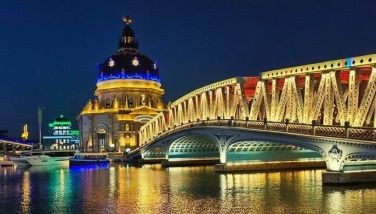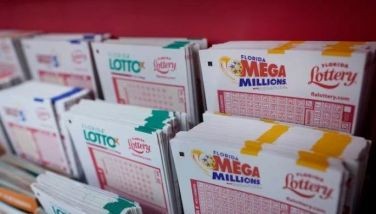When in Naples, be very, very careful
March 6, 2005 | 12:00am
 Any visit to Pompeii would be incomplete without a visit to the National Archaeological Museum of Naples. The museum is the repository of all the treasures excavated in Pompeii. Viewing all these artifacts will round out any visit to the city.
Any visit to Pompeii would be incomplete without a visit to the National Archaeological Museum of Naples. The museum is the repository of all the treasures excavated in Pompeii. Viewing all these artifacts will round out any visit to the city.
So, the day after we visited Pompeii, we were off to Naples, built where the siren Parthenope was washed ashore after having been rejected by Odysseus, seat of the Norman, Angevin, Aragonese and Bourbon kingdoms, and the birthplace of Sophia Loren and the pizza.
While we were in Florence, we mentioned to several friends that we would be staying in the Amalfi Coast and, while there, visit Naples. Without exception, we were warned, in the most baleful of tones, to "be careful, be very, very careful." Every time the mere mention of Naples came up, everyone would say "Be careful, be very, very careful." Even the guidebooks said, "Be careful, be very, very careful," with additional warnings not to bring cameras and large bags or wear watches and jewelry. The words were repeated so often they were like a mantra intoned by a Greek chorus presaging tragedy for two hapless travelers who knew no better. But in our minds, we asked ourselves how Naples could be worse than Manila, whose fame as the shoot ’em up and kidnapping capital of the world far exceeds the truth? And so, we resolved to visit Naples with nary a thought for our safety.
Things got a little dicey, however, when I asked the hotel about Naples.
"Signore, you are going to Napoli? Be careful, be very, very careful. If you must go, don’t wear any jewelry and hide your cameras."
Then I mentioned that we were driving to Naples, and I got this look of extreme concern and utter incredulity.
"Signore, if you must take your car, then we suggest that you drive straight to the Stazione Termini and park there. It is well guarded. And be careful, be very, very careful."
And so we drove off to Naples in a mild state of paranoia.
Upon reaching the train station and after parking our car, my wife and I walked past the parking lot attendant. He took one look at us and said, "Signore, you are carrying a camera. Attenzione. Be careful, be very, very careful. Leave it in your car."
Well, I was not prepared to go to Naples and its famous museum without a photographic record of our trip, so I took it with me anyway. But this time, my wife and I were in a state of utter trepidation.
We went into the train station and changed $400. Then it hit us! We were sitting ducks with $400 worth of Euros in our pockets and a camera around my neck. With the words "Be careful, be very, very careful" ringing in our ears, we left the money changer with our backs against each other while turning around and around to ward off any attackers. My right hand was clutching my camera, while my left hand was in my pocket, clutching my money and my balls. (Who knows? They may want to snatch that, too. Maybe somewhere in this crazy world we live in there is a market for desiccated Asian testes!)
We jumped into a taxi, warily attentive of the route the driver was taking just to make sure he would not drive us straight into an opium den and sell us into white slavery. When we got to the museum, we jumped out of the taxi and ran inside, feeling safe and sound at last.
The decisive impulse for the creation of the National Archaeological Museum of Naples came from the "dynastic and political conjunctures that brought the Spanish Infanta, Charles III Bourbon, to the throne in Naples in 1734." Both Charles and his wife, Maria Amalia of Savoy, were from families of antique collectors. Charles’ mother was born a Farnese, the Roman noble family, which had built up the foremost collection of antiques in Rome. Then as luck would have it, their collections were augmented by the rich collection of August of Saxony. The King also initiated excavations in Herculaneum, which yielded an extraordinary succession of statues in marble and bronze. This signaled the start of an exceptional round of excavations in the cities at the foot of Vesuvius, which continue to this day.
Inside the museum is a collection of Greco-Roman sculpture, which has mostly been excavated around Vesuvius and the Phlegraean Fields, as well as treasures from the Farnese collection. These are mostly displayed around the ground floor. Among the best known are the Farnese Hercules (whose thingy, according to my wife, was disproportionately small compared to his huge body); the Farnesian Bull, which once stood in the Baths of Caracalla in Rome and depicts a woman who, having tormented another woman, is punished by being tied to the legs of a mad bull who mangles her; and the bronze and alabaster Artemis of Ephesos whose multitudinous display of breasts would be paradise to anyone who would want to drown in them. There is a collection of Greek, Roman and Renaissance gems, the highlight of which is the Farnese Cup, a beautiful cameo carved in Egypt around the 2nd and 1st centuries BC. There is a full basement devoted to an Egyptian collection from the Old Kingdom. There are mosaics and frescoes from Pompeii, Stabiae, Herculaneum and Boscoreale, the most famous being the mosaic of Alexander the Great defeating the Persian King Darius in battle. There are whole art collections taken from the Villa dei Papiri and the Temple of Isis in Pompeii. There are artifacts of glass and silver, combs, plates, dishes and other minutiae of everyday life.
The museum harbors one highly restricted room, entry to which needs to be made by appointment. This room contains all the triple X-rated artwork found in the homes and brothels of Pompeii and Herculaneum. There are frescoes and mosaics filled with the couplings and uncouplings of gods and goddesses, men and women, men and men, and men and beasts. There are lamps shaped like penises, tripods held up by satyrs with Brobdingnagian members, and, most salacious of all, Pan ravaging a goat whose languorous look bespeaks enjoyment and ecstasy. All in all, in these closeted rooms, one gets a glimpse of a society where sex was considered a natural impulse to be enjoyed and where most anything was acceptable.
We left the museum happy of our visit. Our fears of theft, disfigurement and white slavery had dissipated. The sun was still high up in the sky, so we decided to take a walk through one of the neighborhoods recommended by my guidebook. We crossed the street, had a cappuccino, and strolled into a vast empty mall, which looked very much like the Galleria in Milan.
Then, in the distance, we saw a figure hurrying towards us with what we thought was some menace. For a moment there, we stood frozen, not knowing whether to stand our ground or run. Then, we realized that the figure was an English tour guide that we had seen the previous day in Pompeii and whom we had also seen leading a tour group in the museum.
He acknowledged our presence and told us, "I wouldn’t venture any further if I were you. You’ll never know what’s lurking yonder in the shadows. I’ve been to Naples so very, many times and it is always best to be careful, be very, very careful."
We ran out of the mall, jumped into the first taxi we could grab, and never saw Naples again.
BrandSpace Articles
<
>



















